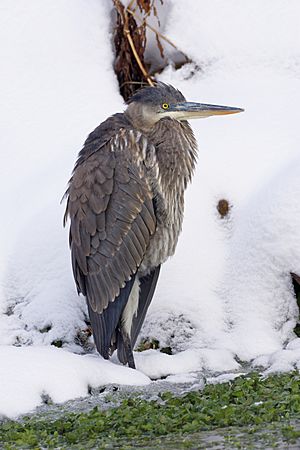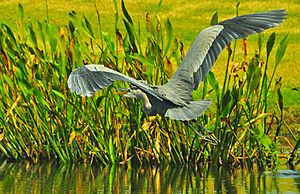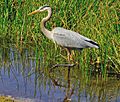Great blue heron facts for kids
Quick facts for kids Great blue heron |
|
|---|---|
 |
|
| Dark form, near Tarpon Springs, Florida | |
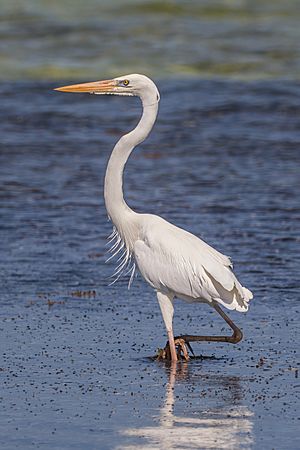 |
|
| White form, possibly A. h. occidentalis, in Cayo Guillermo National Park, Cuba | |
| Conservation status | |
| Scientific classification | |
| Genus: |
Ardea
|
| Species: |
herodias
|
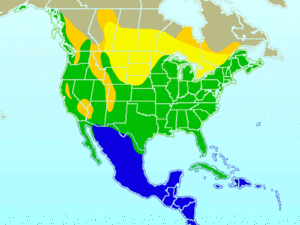 |
|
| Breeding range Year-round range Wintering range Present during migration | |
The great blue heron (Ardea herodias) is a very large wading bird. It belongs to the heron family. You can often spot these birds near the edges of open water or in wetlands. They live across most of North America and Central America. You can also find them in the Caribbean and on the Galápagos Islands. Sometimes, they even visit places like coastal Spain or the Azores.
In southern Florida and the Florida Keys, there's a special all-white group of these birds. They are called the great white heron. Scientists are still discussing if these white birds are just a different color of the great blue heron, a subspecies, or a completely separate species.
Contents
About the Great Blue Heron
The great blue heron was first described by a famous scientist named Carl Linnaeus in the 1700s. He gave it the scientific name Ardea herodias. Both Ardea and herodios are old words meaning "heron."
The great blue heron has a close relative in other parts of the world, called the grey heron. It looks very similar but is a bit smaller. There are five different types, or subspecies, of the great blue heron:
- A. h. herodias: Found in most of North America.
- A. h. fannini: Lives along the Pacific Northwest coast, from Alaska to Washington.
- A. h. wardi: Found from Kansas and Oklahoma down to northern Florida.
- A. h. occidentalis: This is the white form found in southern Florida and the Caribbean islands. It was once thought to be a separate species.
- A. h. cognata: Lives on the Galápagos Islands.
What Does a Great Blue Heron Look Like?
The great blue heron is the biggest heron in North America! It can be up to 137 cm (54 in) tall and have a wingspan of 201 cm (79 in). It usually weighs between 1.82–3.6 kg (4.0–7.9 lb). Male herons are usually a little bigger than females, but they look very similar.
These birds have gray-blue feathers on their wings. Their thighs are reddish-brown, and they have stripes on their sides. Their necks are rusty-gray with black and white streaks. The head is lighter, with a white face and black plumes (long feathers) that go from above the eye to the back of the head.
Their bill is dull yellow, but it turns orange when it's time to breed. Their legs are gray, also turning orange during breeding season. Young herons are duller in color and don't have the fancy plumes.
The great white heron, found in South Florida, is a special white version. It has no color in its feathers at all. It's also a bit larger than other great blue herons. Sometimes, you might see a bird that looks like a regular great blue heron but has a white head. These are called Würdemann's herons.
Similar Birds
It's easy to confuse the great white heron with the great egret. But the great white heron is larger and has yellow legs, while the great egret has black legs. Smaller birds like the reddish egret or little blue heron might look similar, but they are much smaller. They also don't have white on their heads or yellow bills.
In some areas, the great blue heron lives near the cocoi heron. The cocoi heron has a white neck and a black crown. The grey heron from Europe also looks very similar, but it has a solid soft-gray neck.
People sometimes mistakenly call herons "cranes." But you can tell them apart when they fly. A crane flies with its neck straight out, while a heron always flies with its neck curved in an "S" shape.
Where Do Great Blue Herons Live?

Great blue herons live all over North America, even as far north as Alaska in the summer. In winter, many fly south to Florida, Mexico, Central America, or South America. Birds that live in the northern parts of their range usually migrate (travel) south for the winter.
However, some herons are tough and stay in cold northern areas if they can find water that isn't frozen. They can adapt to almost any wet place. You can find them in marshes, swamps, lake edges, or along shorelines. They are very flexible and can even live in busy areas if there's water with fish nearby.
These birds usually stay close to water. They build their nests in trees or bushes near the water's edge. They often choose islands or isolated spots to keep their nests safe from predators.
Behavior and Life Cycle
What Do Great Blue Herons Eat?
The main food for great blue herons is small fish. But they also eat many other things! They might catch shrimp, crabs, water insects, rodents, and other small mammals. They also eat amphibians, reptiles, and even small birds like ducklings. What they eat depends on what's available in their area.
Herons use their excellent eyesight to find food. They usually swallow their food whole. They often hunt alone, standing still in shallow water. When they see prey, they quickly spear it with their long, sharp bill. They can also hunt in fields or drop from the air into the water. Sometimes, they even hunt mice far from water.
Reproduction and Nests
Great blue herons usually breed in large groups called heronries. They build their nests in trees near lakes or other wetlands. Adults return to these nesting sites after winter, usually between December and March. Most heronries only have great blue herons, but sometimes other heron species nest there too.
These colonies can be very large, with anywhere from five to 500 nests! They are usually close to good feeding spots. Heronries are often built in places that are hard for land animals to reach, like islands or high tree branches. This helps protect the eggs and chicks.
Herons often reuse their nests for many years. They are usually monogamous (have one mate) for a single breeding season, but they often choose new mates each year. The male heron arrives first and picks a nest. Then, he tries to attract a female.
They build big nests made of sticks. A new nest is about 50 cm (20 in) wide. But with repeated use, they can grow to more than 120 cm (47 in) wide and 90 cm (35 in) deep!
The female lays 3 to 6 pale blue eggs. Each egg is about 50.7 to 76.5 mm (2.00 to 3.01 in) long. They usually lay one clutch (group of eggs) each year, starting in March or April. The eggs hatch over several days after about 27 days of incubation. Both parents take turns sitting on the eggs to keep them warm.
Both parents feed the young chicks by regurgitating (bringing up) food for them. The first chick to hatch often grows faster. Young herons take their first flight when they are about 55 to 80 days old. They still come back to the nest for food for about three more weeks. Young herons aren't as good at catching fish as adults are at first.
Who Preys on Herons?
Eggs and young chicks can be eaten by turkey vultures, common ravens, and American crows. Larger chicks or young birds learning to fly might be caught by Red-tailed hawks, American black bears, and raccoons.
Adult great blue herons are very large, so they don't have many natural predators. But some big birds of prey, like bald eagles and golden eagles, can hunt them. Bald eagles are known to attack herons at every stage of their life. Sometimes, an adult heron might even be caught by an American alligator or an American crocodile.
A full-grown heron can defend itself with its sharp, dagger-like bill. There was even a case where a heron managed to badly injure a golden eagle that was trying to attack it. If predators disturb a nesting colony too much, the other birds might abandon their nests. Human activities, like recreation or destroying their habitats, can also cause problems for heron nesting.
Great Blue Herons in Art
The famous artist John James Audubon included the great blue heron in his well-known book, Birds of America. He drew a beautiful picture of the bird for Plate 161 in his book.
Gallery
-
Wading at Grande Lakes Audubon Cooperative Wildlife Sanctuary, Orlando, FL
-
Eating a common snapping turtle (Chelydra serpentina) hatchling
Images for kids
-
Perched on a tree in a cemetery in New York
-
Great Blue Heron flying over grass in the Everglades
See also
 In Spanish: Garza azulada para niños
In Spanish: Garza azulada para niños



